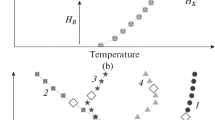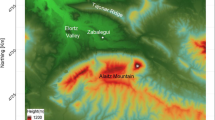Summary
The problem of the influence of radiative flux divergence and turbulent heat exchange on temperature of the near-ground layer of the atmosphere is considered. Different methods of calculating long-wave radiative flux divergence are discussed. The importance of different factors for the thermal regime of the near-ground layer is established by means of the theory of non-stationary heat exchange. The primary conclusions are: 1) temperature changes influenced by radiation and turbulence are not additive; this means that, strictly speaking, separate calculations of either radiative or turbulent temperature changes have no meaning, 2) the theory developed in this paper is sufficiently exact to show that there is a great influence of radiative flux divergence on the thermal regime of the near-ground layer of the atmosphere.
Zusammenfassung
Es wird das Problem des Einflusses der Strahlungsstrom-Divergenz und des turbulenten Wärmeaustausches auf die Temperatur der bodennahen Luftschicht behandelt. Verschiedene Methoden zur Berechnung der Divergenz der langwelligen Strahlungsströme werden diskutiert. Die Bedeutung der verschiedenen Faktoren für das Temperaturregime der bodennahen Luftschicht wird auf Grund der Theorie des nichtstationären Wärmeaustausches festgestellt. Die wichtigsten Schlußfolgerungen sind: 1. Die Temperaturänderungen, die durch Strahlung und Turbulenz hervorgerufen werden, können nicht addiert werden; dies bedeutet, daß eine gesonderte Berechnung der Temperaturänderungen durch Strahlungsvorgänge bzw. durch den Turbulenzwärmestrom streng genommen nicht zulässig ist. 2. Die in der vorliegenden Arbeit entwickelte Theorie erfaßt die tatsächlichen Vorgänge mit genügender Genauigkeit, um zu beweisen, daß die Divergenz des langwelligen Strahlungsstromes für das Temperaturregime der bodennahen Luftschicht von großer Bedeutung ist.
Résumé
Les auteurs traitent ici le problème de l'influence de la divergence du flux de rayonnement ainsi que des échanges turbulents de chaleur sur la température des couches d'air voisines du sol. Ils discutent diverses méthodes permettant de calculer la divergence des flux de rayonnement de grande longueur d'onde. Ils constatent l'importance des divers facteurs sur le régime de température de ces couches d'air voisines du sol et cela sur la base de la théorie des échanges de chaleur non stationnaires. Les conclusions principales sont: 1) les variations de température dues au rayonnement d'une part et à la turbulence d'autre part ne peuvent être additionnées; cela signifie que, si l'on veut être exact, il n'est pas possible de calculer séparément les variations de température dues aux phénomènes de rayonnement, respectivement aux courants thermiques turbulents, 2) la théorie développée dans ce travail embrasse avec suffisamment de précision les effets réels pour démontrer que la divergence du flux de rayonnement à grande longueur d'ondes est d'une importance capitale pour le régime des températures des couches d'air voisines du sol.
Similar content being viewed by others
References
Kondrati'ev, K. Y.: Radiative Heat Exchange in the Atmosphere. Hydrometeoizdat 1956 (in Russian).
Bruinenberg, A.: A Numerical Method for the Calculation of Temperature Changes by Radiation in the Free Atmosphere. Kon. Nederl. Met. Inst., Med. en Verh., 1/I (1946).
Brooks, D. L.: A Tabular Method for the Computation of Temperature Changes by Infrared Radiation in the Free Atmosphere. J. Met.7, No. 5 (1950).
Yamamoto, G., andG. Onishi: A Chart for the Calculation of Radiative Temperature Changes. Sci. Rep. Tohoku Univ., Ser. 5,4, No. 3 (1953).
Kondrati'ev, K. Y., andK. E. Yakushevskaya: The New Method of Calculation of Radiative Flux Divergence. Proc. Leningrad Univ., 210, Ser. Phys.9 (1956), (in Russian).
Deacon, E. L.: Radiative Heat Transfer in the Air Near the Ground. Austral. J. Sci. Res., Ser. A,3, No. 2 (1950).
Robinson, G. D.: Two Notes on Temperature Changes in the Troposphere Due to Radiation. Cent. Proc. Roy. Met. Soc., 1950.
Rider, N. E., andG. D. Robinson: A Study of the Transfer of Heat and Water Vapour Above the Surface of Short Grass. Quart. J. Roy. Met. Soc.77, No. 333 (1951).
Czepa, O.: Über die Energieleitung durch langwellige Strahlung in der bodennahen Luftschicht. Z. Met.5, No. 10 (1951).
Yamamoto, G.: Effect of Radiative Transfer on the Vertical Distribution of Temperature in the Troposphere. Sci. Rep. Tohoku Univ., Ser. 5,4, No. 2 (1952).
Möller, F.: Strahlungsvorgänge in Bodennähe. Z. Met.9, No. 2 (1955).
Laichtman, D. L.: Present State and Main Problems of the Physics of the Lowest Layers of the Atmosphere. Proc. Main Geophys. Obs., 53 (1955), (in Russian).
Berliand, M. E.: Forecasts and Regulation of the Heat Regime of the Atmosphere Near the Ground. Hydrometeoizdat 1956 (in Russian).
Budyko, M. I., andM. I. Yudin: Heat Exchange Between the Earth's Surface and the Atmosphere, and Equilibrium Temperature Gradient. Met. Hydrol.1 (1947), (in Russian).
Geiger, R.: Das Klima der bodennahen Luftschicht. Moscow, 1960 (Russian Translation).
Lake, J. V.: The Temperature Profile Above Bare Soil in Clear Nights. Quart. J. Roy. Met. Soc.82, No. 352 (1956).
Fleagle, R. G.: The Temperature Distribution Near a Cold Surface. J. Met.13, No. 2 (1956).
Raschke, K.: Über das nächtliche Temperaturminimum über nacktem Boden in Poona (Indien). Met. Rdsch.10, No. 1 (1957).
Niilisk, H., andH. Moldau: Night Temperature Minimum Above Natural Surfaces. Invest. Atm. Phys. Tartu2 (1960), (in Russian).
Möller, F.: Über das Strahlungsgleichgewicht in der Nähe der Erdoberfläche. Met. Rdsch.13, No. 5 (1960).
Malkin, N. R.: Distribution and Variation of Temperature at Different Heights, Under the Influence of Radiative and Turbulent Heat Exchange. Proc. Main Geophys. Obs., Iss. 2,64 (1947), (in Russian).
Shvetz, M. E.: On the Influence of Thermal Radiation on Air Temperature. Proc. Main Geophys. Obs., Iss. 2,64 (1947), (in Russian).
Kondrati'ev, K. Y.: Correlation of the Mechanisms of Turbulent and Radiative Heat Transfer in the Atmosphere Near the Ground. Sci. Bull. Leningrad State Univ.24 (1949), (in Russian).
Malkevitch, M. S.: Air Temperature Variation with Time, Under the Influence of Turbulent Mixing and Radiative Heat Exchange. Proc. Geophys. Inst. Acad. Sci. USSR, 37 (1956), (in Russian).
Kraus, H.: Untersuchungen über den nächtlichen Energietransport und Energiehaushalt in der bodennahen Luftschicht bei der Bildung von Strahlungsnebeln. Ber. Dtsch. Wetterdienst7, No. 48 (1958).
Funk, J. P.: Measured Radiative Flux Divergence Near the Ground at Night. Quart. J. Roy. Met. Soc.86, No. 369 (1960).
Funk, J. P.: A Numerical Method for the Computation of the Radiative Flux Divergence Near the Ground. J. Met.18, No. 3 (1961).
Author information
Authors and Affiliations
Additional information
Dedicated to Dr.W. Mörikofer on the occasion of his 70 th birthday.
With 1 Figure
Rights and permissions
About this article
Cite this article
Gaevskaya, G.N., Kondrati'ev, K.Y. & Yakushevskaya, K.E. Radiative heat flux divergence and heat regime in the lowest layer of the atmosphere. Arch. Met. Geoph. Biokl. B. 12, 95–108 (1962). https://doi.org/10.1007/BF02317955
Issue Date:
DOI: https://doi.org/10.1007/BF02317955




